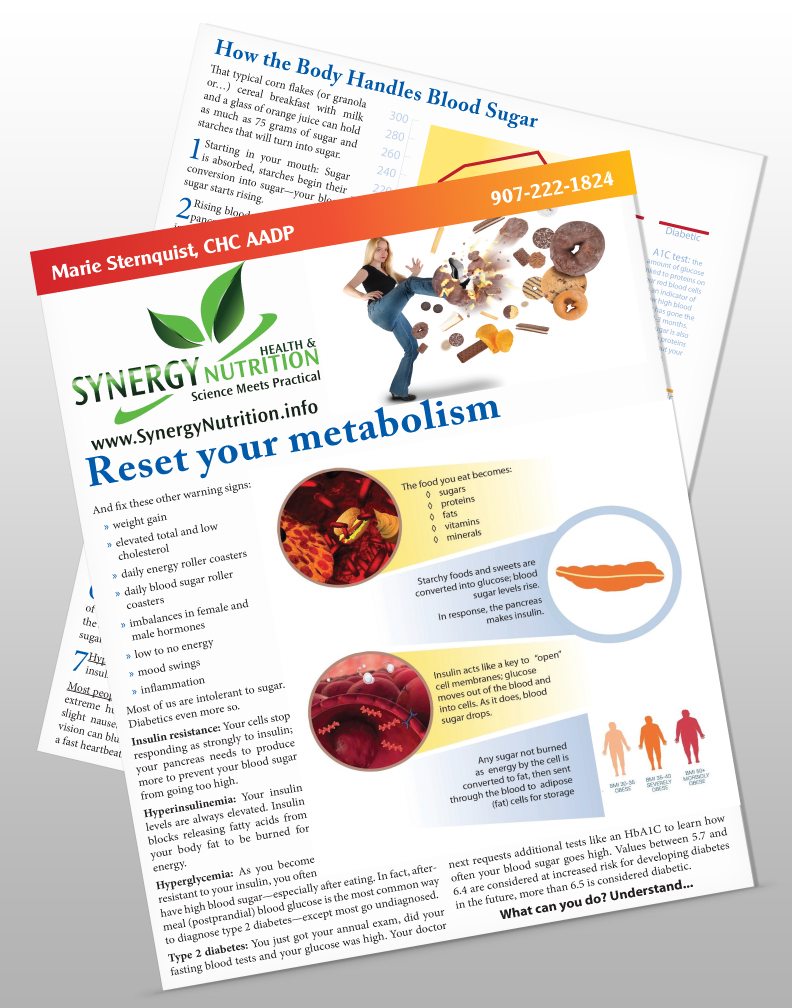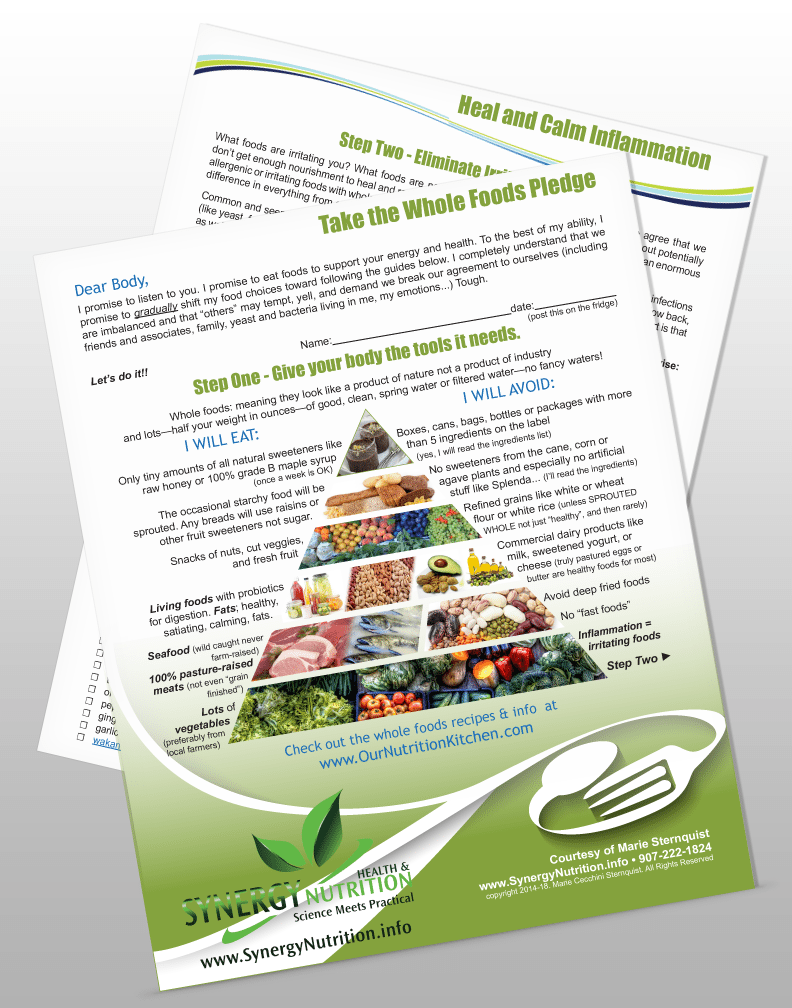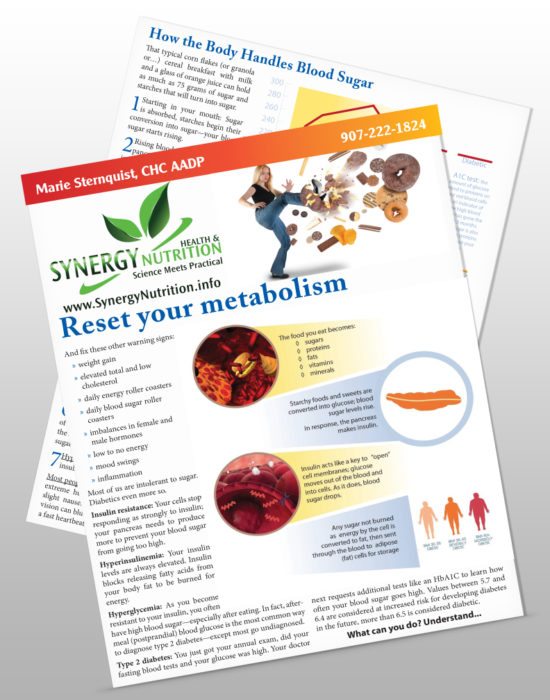There is a modern epidemic, a deadly disease that one of every two of you have, a disease that’s making you fat, sick, and will kill you. It isn’t infectious and 90 percent of you don’t even know you have it. It’s called “diabesity” and includes our modern diet diseases of diabetes, elevated blood sugar, blood pressure, and triglycerides.
“Diabesity” or Metabolic Syndrome progresses like this:
- Depending on your unique genetics, living on bread, pasta, and other convenience or “comfort” foods, not sleeping enough—or well, perhaps being under a lot of stress, and all while exposed to environmental toxins creates inflammation and other imbalances.
- Those empty calories–usually an abundance of quickly absorbed sugars, liquid calories, and carbohydrates (like bread, pasta, rice, and potatoes)—deprive your cells of the tools they need to detoxify.
- Because these sugars are quickly absorbed, your body needs to make more insulin to keep the blood sugar from rising too much.
- Your cells slowly become resistant to insulin—your pancreas must send out more to get it to work.
- You get an appetite that is out of control, weight gain around the belly, more inflammation and oxidative stress, and a whole bunch of other problems including high blood pressure, high cholesterol, low HDL, high triglycerides, hormone imbalances, thickening of the blood, and increased risk of cancer, Alzheimer’s, and depression.
Want some good news?
Metabolic syndrome is completely reversible even if you have been put on the multiple blood pressure, cholesterol lowering, and blood sugar lowering medications typical of most of my clients.
Think of diabesity as carbohydrate intolerance. When you can’t tolerate something, what should you do? Most people answer the obvious: restrict the offending dietary component.
When this occurs—when obese or diabetic patients restrict carbs—their symptoms improve, often to a greater degree than diabetic patients on other diets and especially better than weight loss programs that count calories.
Let’s take a closer look.
Common features of diabesity

Insulin resistance: Your cells don’t respond as strongly to insulin, and you need more to produce the desired effect.
Hyperinsulinemia: Your insulin levels are always elevated. This inhibits you from releasing fatty acids from your body fat to be burned for energy.
Hyperglycemia: Because you’re not very good at using insulin to remove glucose from the blood, you often have high blood sugar—especially after eating. In fact, postprandial (post meal) blood glucose is the most common way to diagnose type 2 diabetes.
Possible approaches: Could reducing carbs or even going keto solve the problem?
It depends. In theory:
Excess body weight: If you can lose weight your insulin sensitivity will improve.
Hyperglycemia: Your blood sugar won’t spike if you limit carbs or eat them intelligently.
Hyperinsulinemia: Your insulin must be low in order to burn fat for fuel (which you must do in order to lose weight).
Insulin resistance: This is tricky and has a lot of false information to it. Diets that go very low carb can actually cause a type of insulin resistance. The reason for this is to conserve the low amount of blood sugar (glucose) in order to keep it available to those areas in the brain that cannot use short-chain fats for fuel. This is perfectly natural; however, you may need to gradually lower your carbs to avoid energy slumps and unwanted harmless effects.
Does it work in real life?
A century ago, there was no such thing as insulin therapy; it hadn’t been invented. Instead, doctors corrected diet and lifestyle.
Lowering carbs has been standard care for nearly a century
Dr. Elliot Joslin’s Diabetic Diet in 1923 consisted of meats, poultry, fish, clear soups, gelatin, eggs, butter, olive oil, coffee, and tea, providing approximately 5% of energy from carbohydrates (25 grams for a 2000 calorie diet), 20% from protein (100 grams), and 75% from fat (190 grams).
Despite pharmaceutical marketing to take-a-pill-to-solve-every-pain-or-problem, you can still find doctors and other professionals who’d love to help you make diet and lifestyle changes and have obtained specialized training to do it well. Your insurance will only cover short visits and medications.
What Studies Tell Us
Study #1: Medium carb vs Ketogenic (<20g carbs/day)
84 obese patients with type 2 diabetes were randomly assigned to either a ketogenic diet that didn’t count calories but restricted carbs OR a “low-cal, low glycemic” diet that averaged 180g daily carbs but lowered daily calories by 500cals/day. For 24 weeks participants met weekly for dietary counseling and support; they completed food logs and were told to exercise 30 minutes 3 times a week.
What happened?
Low-glycemic group:
- 16% reduction in fasting glucose
- 9 kg bodyweight loss
- 5 reduction in HbA1c
- 62% of participants eliminated or reduced their medications
Keto group:
- 20% reduction in fasting glucose
- 1 kg bodyweight loss
- 5 reduction in HbA1c
- 95% of participants eliminated or reduced their medications
The bottom line: Both dietary strategies can help. Try to reduce carbs as much as possible but never feel guilty—there is definitely some “wiggle room.”
Study #2: Low Carb vs Ketogenic
363 overweight and obese patients (of which 102 also had diabetes). These patients got to choose the diet that most appealed to them—more like what happens in the real world. And both groups were allowed nearly 2200 calories per day depending on weight.
And once again, both groups improved metabolic health and blood sugar, but the keto group saw greater improvements on every single marker measured:
- Blood lipids (triglycerides, cholesterol profile)
- Body weight
- Waist circumference
- HbA1c (tests the extent to which blood sugar was elevated in the past 3 months)
- Blood glucose (tests current status of blood sugar)
- Uric acid (tests kidney function—may change with high protein diet)
- Urea (tests kidney function—may change if wasting muscle)
- Creatinine (tests kidney function)
The drop in blood glucose in diabetics using a ketogenic plan required constant reduction in insulin doses, so much so that the research team recommended this be done under medical supervision.
Study #3: Low Carb vs Low Fat
First of all, this was a “boot camp” for its 600+ participants. Per the researchers:
“both groups were asked to make large initial changes from their baseline habitual diets. …both diet groups were instructed to incorporate significant variety and quantity of vegetables into their daily diets and to minimize added sugars and refined grains.”
As there are no definitions for “low carb” or “low fat”, the researchers gave them targets of <20 grams of carbs or <20 grams of fat for the first month and then allowed them to increase their carbs or fats to whatever they felt they could sustain without increasing calories.
Each group met 22 times (initially weekly, then more spread out) with a Registered Dietician. They shared community resources for “good eggs” and “healthy produce;” they cooked at home more and shared recipes; they discussed the psychology of eating and how that impacts decisions. The groups kept food logs. Four times during the year they were measured, had their blood tested for various markers of health, and completed an interview regarding their diet (to pick up things that might have been forgotten in their logs). They were told to exercise 60-90 minutes each day.
What happened?
The “Low Carb” group averaged 132 grams of carbs—well above the 50 gram threshold to put them into ketosis; the”Low Fat” group averaged 57 grams of fat, or about 25% of their calories from fat—the U.S. dietary reference intake (DRI) for fat in adults is 20% to 35% of total calories.
- Both groups lost weight equally (Low Carb averaged 13.2 pounds, Low Fat averaged 11.7 pounds)
- Both groups had winners and losers (individuals in both groups lost as much as 60 pounds while others actually gained weight).
- The low carb group increased HDL cholesterol and lowered their triglycerides while the low fat group decreased LDL cholesterol.
The bottom line? One diet doesn’t fit all.
Numerous studies have attempted to identify the one successful weight loss strategy that works best for most people. Yet most of these diet trials have reported only modest mean weight loss (i.e., < 5% initial body weight) after 12 months or longer.
Would you be happy losing 10 pounds in 12 months? Probably not.
But here’s why this is misrepresented: Since when are we “average”? (statistically that’s known as the “mean”)
Each and every one of these studies showed a huge difference from one person to the next. In other words, regardless of diet, some people in each group lost 50 pounds and others gained weight. When this is all averaged together, it doesn’t look like there is any difference.
If I were the person who lost 50 pounds would I become that diet’s poster child? Absolutely! I’d write glowing testimonials for book jackets and landing pages. I’d be ecstatic!
If I were the average person who hadn’t though… I might just think nothing could be done about it.
Please be aware of what else you might hear.
First off, ALL of these diets are far better than what is sold in weight loss programs. You will not lose weight or handle your diabesity by eating cheap processed “low fat” or “low carb” diet food, or diet shakes, or taking the next fad herb only available for a lot of money online. Period.
Second off, ALL of these diets are better than what is currently being taught to people seeking weight loss, and especially diabetics enrolled in standard educator programs.
This is CRAZY but it’s what’s being taught:
- 45-60 grams of carbs per meal, PLUS
- 15-30 grams of carbs for snacks.
At three meals and two snacks a day, you’re looking at a whopping 240 grams of carbohydrates for a person with diabetes who needs to lose some weight. CRAZY! However, some Certified Diabetic Educators are jumping off this bandwagon.

What works? The Whole Foods Pledge
- More whole foods
- More vegetables, specifically—ANY and ALL of them (seeds are not vegetables yet)
- Less added sugar (probably none)
- Less refined grains (probably none)—some seeds are fine
Those four points are in every type of diet I can think of — vegan, paleo, low-fat, low-carb, Mediterranean, all of them.
After that, consider your Personal Satiety Items. Do you love potato chips (not the flavored, maltodextrin or sugar coated ones!)? Or lentils? (carbs) or do you prefer avocados and nuts (plant-based protein-fats) or perhaps you lean towards something like tuna and eggs (animal-based protein-fats).
Before worrying about the details, one should ensure their diet is more whole foods (with ample vegetables) than processed foods. If your chosen diet leaves you feeling hungry, you will likely revert back to old eating habits.
What else works?
Changing your relationship with food.
This is so important an entire future article (or a few) will cover this. But in a nutshell, work on mindful vs mindless eating:
- please don’t eat in your car or in front of a screen
- eat with friends and family more often
- shop at local farmers markets
Thanks for reading, everyone. Take care!

Osler W, McCrae T. The principles and practice of medicine. New York: Appleton and Co; 1923
Gardner, C. D., Trepanowski, J. F., Del Gobbo, L. C., Hauser, M. E., Rigdon, J., … King, A. C. (2018) Effect of Low-Fat vs Low-Carbohydrate Diet on 12-Month Weight Loss in Overweight Adults and the Association With Genotype Pattern or Insulin Secretion: The DIETFITS Randomized Clinical Trial. JAMA. 319(7):667–679.
Hussain, T.A., Mathew, T. C., Dashti, A. A., Asfar, S., Al-Zaid, N., Dashti, H. M. (2012) Effect of low-calorie versus low-carbohydrate ketogenic diet in type 2 diabetes. Nutrition, 28(10):1016-21
Stanton, Michael V., Robinson, Jennifer L., Kirkpatrick, Susan M., Farzinkhou, Sarah, Avery, Erin C., Rigdon, Joseph, . . . Gardner, Christopher D. (2017). DIETFITS study (diet intervention examining the factors interacting with treatment success) – Study design and methods. Contemporary Clinical Trials, 53, 151-161.
Yancy, W. S., Foy, M., Chalecki, A. M., Vernon, M. C., & Westman, E. C. (2005). A low-carbohydrate, ketogenic diet to treat type 2 diabetes. Nutrition & Metabolism, 2, 34.


Leave a Reply
You must be logged in to post a comment.